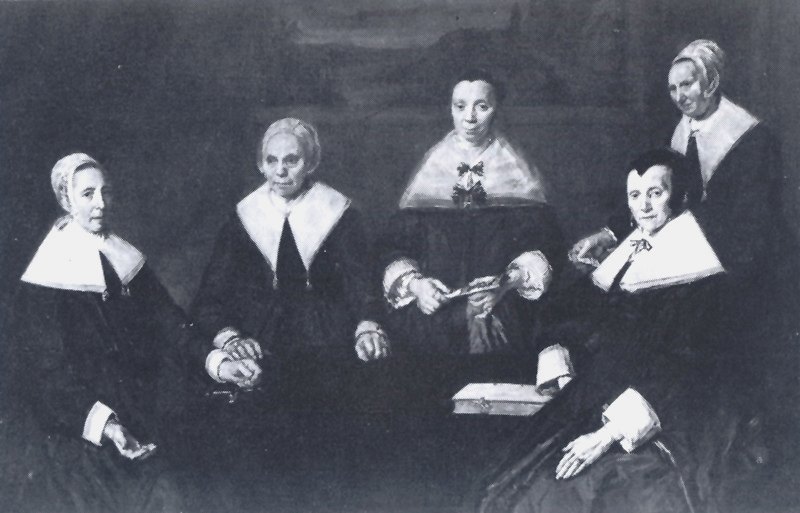
Frans Hals Women Governors of the Haarlem Almshouse 1664
Haacke Hans (1936– ). German-American artist. In his ‘real-time systems’ H. combines materials, styles and words taken from the everyday capitalist experience – politics, social issues, corporate industry and advertising – in works that critique such experience and its relation to art (e.g. Creating Consent, 1981, which exposes Mobil Oil’s expenditure on advertising). His work has been directed against art institutions, and their links with industries, such as the Guggenheim and the Metropolitan Museums, N.Y., the public relations company Saatchi and Saatchi, ex-President Reagan, ex-Prime Minister Thatcher and others. His notorious Manet Project (1974) used Manet’s Bunch of Asparagus as a centrepiece surrounded by an exposé of all the collectors who had acquired it at different times, including its last owner who was the founder of a museum in Cologne, aiming in this, as in other works, to expose and discredit the image of the world which art may unwittingly promote and whose interests it may serve.
Haberle John (1856–1933). U.S. painter who, like Peto, specialized in trompe l’œil still-lifes for which he is best known.
Hague school. A group of Realist artists who worked in Holland between 1860 and 1900, reviving many of the traditions of 17th-c. Dutch landscape and architectural painters. The group included Bosboom, Jozef Israëls, Mauve and the Maris brothers.
Haida. North American Indian people of the North-west Coast group, centred in the Queen Charlotte Islands of British Columbia. They are noted for a tradition of powerful wood carvers whose finest work was in the totemic house and grave poles (totem poles).
Hains Raymond (1926–2005). French Nouveau réaliste artist and photographer who worked closely with Villeglé and Rotella. He pioneered the décollage technique of found and torn poster abstracts in 1949, which he termed affiches lacérées, e.g. Cet homme est dangereux (1957). Vostell.
Halley Peter (1953– ). U.S. painter and chief theorist of Neo-Geo (‘Neo’). Despite the abstract look of his strongly coloured paintings, H. denies that they are abstracts. Their geometric imagery refers, on the one hand, to such modernist artists as Albers, but also, metaphorically, to the cell-like isolation of individuals in the urban world, as well as to electronic circuitry, comics and the mapping of underground networks.
Hallstatt. Site in Austria which has given its name to the 1st W. European Iron Age culture; the H. period produced a geometrical art less interesting than that of the subsequent La Tène period.
Hals Dirck or Dirk (1591–1656). Dutch painter. His painting is close in style to that of his brother, the more famous F. H. His best-known works are convivial gatherings such as A Party of Young Men and Women at Table.
Hals Frans (1580/5–1666). Dutch portrait painter. H. lived all his life in Haarlem. He probably studied under K. van Mander and may have visited Rubens in Antwerp (1616). He must have won a considerable reputation as a portrait painter prior to 1616, when he was commissioned to paint The Banquet of the Haarlem Civic Guard, Archers of St George. In this work H. confidently solves the enormous problems of composition involved in a group portrait where no figure can be subordinate. Other militia portraits were commissioned for the same mess in 1627, 1633 and 1639, while H.’s fame had spread to Amsterdam, whose Civic Guard he was invited to paint in 1633, a picture he left unfinished. Married, with numerous children, one an imbecile, another a delinquent, H. was in continuous financial difficulty. He gave lessons and among his pupils were probably Brouwer, Leyster, Molenaer and Wouwerman. In 1641 H. painted The Governors of St Elizabeth Hospital. In 1644 the entrance fee of the Haarlem Guild was waived to allow H. to become a member. In 1664, in return for a small grant of money and fuel from the city, H. painted 2 of his most masterful and technically bold group portraits, Men … and Women Governors of the Haarlem Almshouse. Of his single portraits, perhaps the best known is the one called The Laughing Cavalier. Among others which show the brilliance of his brush-work and which capture the spontaneity of gesture he was famous for, are Gipsy Girl, Elderly Woman, Hille Bobbe, or The Witch of Haarlem and Young Couple in a Landscape. H. was an important influence on Manet.

Frans Hals Women Governors of the Haarlem Almshouse 1664
Hamilton Ann (1956– ). U.S. Installation and Environmental artist. In a statement (with her frequent collaborator, artist Kathryn Clark) it is said that ‘making site-related work – work that is ephemeral and constituted of organic materials – is part of retracing the path toward art that is among the living, and therefore among the dying’. Her usually temporary works are immensely evocative, poetic metaphors of innocence, collective memory and loss. H. uses birds, animals, people, objects, honey, wax and any other animate or inanimate material that may serve in realizing her vision, e.g. Privations and Excesses (1989) where 750,000 pennies are arranged in overlapping patterns, imbedded in a layer of honey spread over the floor. Also, The Savage Garden and View – in collaboration with Kathryn Clark – (both 1991) and Parallel Lines and Accounting (both 1992).
Hamilton Gavin (1723–98). Scottish Neoclassical history and portrait painter and antiquary. After studying in Rome he worked as a portrait painter in Britain (c. 1752–4), then settled in Rome. There he became an important member of the Neoclassical school centred round A. R. Mengs and J. J. Winckelmann.
Hamilton Richard (1922–2011). British artist. He studied at the R.A. Schools (1938) but his art training was interrupted by the war when he was trained as engineering draughtsman. He taught for 14 years, first at the Central School of Arts and Crafts, London, and then at the University of Newcastle-upon-Tyne. H. was largely responsible for the radical developments which transformed British art in the 1950s and 1960s: his seminal role in the birth of Pop art is acknowledged internationally. Although best known as a painter and maker of prints, his influence has been exercised also through teaching, writing, and through a number of exhibitions, e.g. ‘Growth and Form’ (1951), ‘Man, Machine and Motion’ (1955) and ‘This is Tomorrow’ (1956). His publications include Collected Words (1953–82).
Hammons David (1943– ). African-American artist who articulates the African-American experience of inner-city life through assemblages and installations in which he juxtaposes objects signifying African culture with found waste, e.g. discarded food, packaging, etc. His House of the Future (1991), an Installation for the ‘Places with a Past’ exhibition at Charleston, South Carolina, became an educational centre devoted to African-American culture. Constructed from materials found in the area, it evokes the living conditions of black people in the South, while alluding to the prosperity of the white community.
Han. Chinese dynasty (206 BC–AD 220), a period of imperial expansion and Confucianist orthodoxy modified by the introduction of Buddhism (c. 1st c. AD). Fine bronze, lacquer and jade objects survive but of the great wall paintings which decorated the palaces only a few tomb paintings are left – notably at Liao-yang, S. Manchuria and Wang-tu, Hopei province. The style is naturalistic and vigorous with affinities to calligraphy. Funerary sculptures includes the 1st Chinese monumental stone carving, e.g. at the tomb of General Ho Ch’u-ping (d. 117 BC), Hsing-p’ing, Shensi and magnificent small bronzes, notably the famous Horse Poised on a Swallow, from a tomb at Lei-t’ai, Kansu.
Hanson Duane (1925–96). U.S. Super-Realist sculptor of life-size and life-like figures of ordinary Americans, made with plastic materials (reinforced polyester resin and fibreglass) which result in extraordinary and disconcerting verisimilitude. The subjects and types chosen may express a critical attitude towards the social types they represent (e.g. Tourists, 1970) or the society that produces them.
Hans von Tübingen (d. 1462). Austrian painter trained in France and Burgundy and active from 1433 in Wiener-Neustadt.
Happening. An apparently impromptu situation, performance, event or series of events sometimes contrived to generate participation by onlookers. The H. was developed in the late 1950s and early 1960s in the U.S.A. Random responses from the spectator-performers are often part of the H. whose purpose is to rupture the barriers between ‘art’ and ‘life’. Kaprow’s 18 Happenings in 6 Parts, Reuben Gal., N.Y. (1959) and Oldenburg’s Store Days (1962) are typical early examples. H.’s were mounted in Europe and Japan.
Hard-edge painting. A term coined in 1958 by the Los Angeles art critic Jules Lansner to describe the work of local artists using cleanly defined forms and flat colour. By extension, any modern abstract painting with these characteristics.
Haring Keith (1958–90). U.S. artist whose graffiti-like drawings of children, dogs, UFOs and AIDS-inspired images made him one of the art celebrities of the 1980s. He also painted and sculpted, and designed stage-sets, murals, record covers and logos. As the critic Germano Celant has observed, H. ‘had the singular ability to depict the complexity of the present with both its sublime and horrifying aspects as well as its marvelous and monstrous forms.’
Harnett William Michael (1848–92). Irish-born U.S. still-life painter, a virtuoso exponent of trompe l’œil illusionism. Interest in his work was revived by the Surrealists.
Harper William (1873–1910). African-American artist born in Canada. He studied at the Art Institute of Chicago and in Paris and was considered one of the most gifted black artists at the turn of the century. His paintings of French landscapes (e.g. Landscape with Poplars (Afternoon at Montigny), c. 1898) show the influence of the Barbizon school.
Harpignies Henri-Joseph (1819–1916). French landscape painter, a follower of Corot.
Hartigan Grace (1922–2008). U.S. Abstract Expressionist painter influenced by De Kooning. She made her 1st abstract paintings in 1948; after a period of figurative work (1952–5) in which she painted Grand Street Brides (1954) she returned to abstraction but her compositions almost always relate to her environment.
Hartley Marsden (1877–1943). U.S. painter and poet, best remembered for his paintings of his native state, Maine, e.g. Camden Hills From Baker’s Island, Penobscot Bay, though his extensive travels in Mexico, the West Indies, France and Germany also inspired many works, e.g. Portrait of a German Officer, or Painting No. 5 1914.
Hartung Hans (1904–89). German-born painter of the school of Paris where he settled in 1935. H. experimented with abstract drawings as early as 1922. In the 1930s he explored variants of Cubism and Surrealism. In the 1940s he developed a style of free linearism over colour fields which he subsequently developed.
Harunobu Suzuki (c. 1725–70). The great 18th-c. master of the Japanese colour print. His main themes were girlhood and scenes from everyday life, and he endowed these commonplace subjects with a grace and beauty far excelling anything in the Japanese tradition before or after his time.
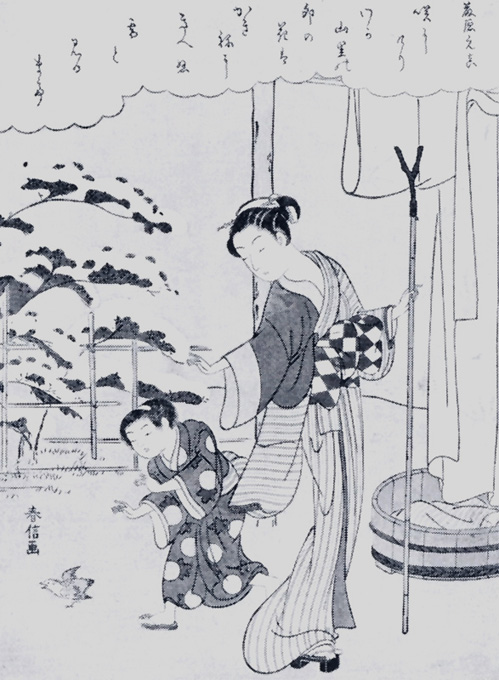
Harunobu Mother and Child with Bird
Hassam Childe (1859–1935). U.S. painter and graphic artist. After studying in Boston he went to Paris, where he was strongly influenced by the technique and high colour range of the Impressionists. He was one of the 1st U.S. artists to adopt Impressionism and also to paint the N.Y. scene.
hatching. To create the effect of tone or shadow by a series of parallel lines or, in the case of Cross-Hatching, of parallel lines crossed by others.
Hausmann Raoul (1886–1971). Austrian-born Dadaist, one of the co-founders – with Grosz, Heartfield, Huelsenbeck and others – of the ‘Club Dada’ in Berlin in 1918, one of the signatories of the Berlin Dada Manifesto (1918) and editor of the magazine Der Dada. H. developed first, along with other Berlin Dadaists, the method of photomontage. H. wrote: ‘seized with an innovatory zeal, I also needed a name for this technique, and in agreement with Grosz, Heartfield, Baader, and Höch, we decided to call these works photomontages. This term translates our aversion at playing the artist, and, thinking of ourselves as engineers … we meant to construct, to assemble our works.’ H. also edited the Dada Almanack (1920) and was one of the key participants at the Berlin Dada Fair in June 1920.
Hayden Henri (1883–1970). Polish-born painter who settled in Paris in 1907. His interest in Cézanne and a meeting with Gris and Delaunay in 1916 led him to work as a Cubist, but in 1922 he turned to a more traditional style.
Hayden Palmer (1890–1973). African-American artist who, after studying at the Cooper Union School of Art in N.Y. and at the Boothbay Art Colony in Maine, received the coveted Harmon Foundation award which enabled him to go to France in 1927. In Paris he enrolled at the École des Beaux-Arts and soon after successfully exhibited his works associated with the final years of the Harlem Renaissance. After returning to N.Y. in 1932, he worked on the U.S. Treasury Art Project and the W.P.A. In 1944 he began a series, Ballad of John Henry (until 1954), on the life of the legendary African-American folk hero.
Haydon Benjamin Robert (1768–1846). British historical painter and writer, a friend of Wordsworth and Keats. His attempts to paint in the grand manner were not successful and he committed suicide after imprisonment for debt. Chairing the Member is an example of his style. In his clear-eyed and vivid Autobiography and Memoirs (1853) H. discusses art patronage and chronicles the art world of his time.
Hayman Francis (1708–76). British painter and book ill., founder-member of the R.A. He was best known for his decorative paintings at Vauxhall Gardens, London. He also painted portraits and small portrait groups which influenced the young Gainsborough. H.’s work shows French influence, possibly through contact with H. Gravelot.
Hayter Stanley (William) (1901–88). British graphic artist responsible for giving a new impetus to engraving techniques, widely extending their field of reference by his imaginative use of mixed techniques. In Paris he founded (1927) the influential experimental workshop Atelier 17.
Head Tim (1946– ). British artist who studied with R. Hamilton at the Univ. of Newcastle-upon-Tyne (1965–9) and on the Advance Sculpture course run by Flanagan at St Martin’s School of Art (1969–70). In his work he employs a variety of media and forms: installations, using mirrors and light, projections, printed and painted serial imagery, and patterned pictures, e.g. the Installations Displacements (1975), Appearance/Apparition (1977), Dislocations (1977) and Present (1978); wall paintings of bar codes in Techno-prison (1990); Cibachrome photographs of combined found objects as in State of the Art (1984) and Erasers (1985); and paintings, e.g. Cow Mutations (1986) and Deep Freeze (1987).
Heade Martin Johnson (1819–1904). U.S. painter, one of the principal figures of Luminism. His landscapes include the dramatic coast scene Approaching Storm (c. 1860).
Heartfield John (Helmut Herzfelde) (1891–1968). German pioneer of photomontage and a founder of Berlin Dada in the 1910s. In Britain from 1938, he settled in E. Germany in 1950. A Communist, H. fought relentlessly against Nazism, capitalism and war, in renowned satirical montages.
Heckel Erich (1883–1970). German Expressionist painter and graphic artist, with Kirchner and Schmidt-Rottluff founder of Die Brücke. The brooding introspection of his work up to 1920 gradually diminished and he turned away from Expressionism, developing a more decorative style and a lyrical sensitivity to landscape. He produced important woodcuts such as The Crouching One (1914) which conveys his tragic sense of man’s isolation.
Heda Willem Claesz (1594–1682). Dutch still-life painter who worked in Haarlem in the manner of P. Claesz. H.’s son Gerrit Willemsz worked in the same style.
Heem Jan Davidsz de (1606–83/4). Dutch still-life painter, as was his father, David de H. (1570–1632). He worked mainly in Antwerp but also in Leyden and Utrecht. He specialized in elaborate flower pieces influenced by those of D. Seghers but used a lighter range of colours. He had many pupils and imitators including his son Cornells (1613–95).
Heemskerck Maerten Jacobsz van (1498–1574). Dutch painter of portraits and religious subjects, pupil of J. van Scorel, from whom he learned an Italianate style which he further established in Rome (1532–5). There he made sketches which give important information about the appearance of classical monuments in the 16th c.
Heian. Period in Japanese history (784–1185) when the capital was Heian-kyo (now Kyoto). Japanese art of Early H. known as Konin and Jogan (784–897) was shaped by the esoteric Tendai and Shingon sects derived from Chinese Buddhism and introduced respectively by the monks Saicho and Kukai (d. 835). Painters, generally monks, produced involved, though often finely drawn, mandalas, portraits of Buddhist saints and portrayals of elemental divinities, often in violent colours. Shingon (the True Word sect), an occult branch of Buddhism, encouraged heavily symbolic sculptures, generally in unpainted wood. Later H. (897–1185) is commonly called the Fujiwara period.
Heizer Michael (1944– ). U.S. artist who, like Smithson, often works on a vast scale (Complex One/City, 1972–6). A leading Earth work artist, H. creates ‘negative objects’ which are rarely documented. In Double Negative he excavated 40,000 tons of earth and rock in 2 sq. miles of desert.
Held Al (1928–2005). U.S. painter; he studied in N.Y. and Paris. He moved from Abstract Expressionist canvases in the 1950s to simplified forms and monumental scale. Works like Ivan the Terrible (1961) and B/W XVI (1968), both acrylic on canvas, are abstract compositions built from schematic geometric forms.
Hélion Jean (1904–87). French painter. He collaborated with Van Doesburg on the pamphlet Art Concret and was a member of the Abstraction-Création group. He spent several years in the U.S.A. After working under the influence of the Cubists and Mondrian he reverted to representational painting.
Hellenistic. Dating from the time of Alexander the Great’s successors (c. 323–c. 50 BC). Such art was produced in a variety of styles, from the baroque to the archaistic, throughout the territories Alexander had conquered, from Egypt to the borders of India.
Heist Bartholomeus van der (1613–70). Dutch portrait painter who worked in Amsterdam and replaced Rembrandt in popular estimation. Although not in the class of Rembrandt or Hals, both of whom influenced his work, H. produced well-composed portrait groups, e.g. Banquet of the Civil Guard, 1648.
Henri Robert (1865–1929). U.S. Realist painter who studied at Pennsylvania Academy of Fine Arts and in Paris, and in the 1890s founded the group called ‘Philadelphia Realists’, later The Eight; an organizer of the Armory Show. He was an important and stimulating teacher, encouraging his pupils to seek inspiration in the contemporary scene. Some of his essays and classroom notes were publ. as The Art Spirit (1923).
Hepworth Barbara (1903–75). British sculptor. Born at Wakefield, Yorkshire, H. was taught modelling at Leeds Art School and carving, chiefly in Italy. Early works such as Doves (stone, 1929) already give an impression of monumental power in repose, close in spirit to Egyptian art. Her work became more abstract and was allied to that of H. Moore and the painting of her 2nd husband, B. Nicholson (marriage dissolved). In 1933 she joined the Abstraction-Création group, Paris, and met Mondrian. She was a member of the Circle Group, London (1935), and joined in the group publ. Circle (1937). Her work won far wider recognition after World War II. She was awarded the C.B.E. in 1958 and foreign awards include the International grand prix, São Paulo Biennale, 1959. Her drawings include those of surgeons and operating theatres (exhibited in 1947). She also designed sets and costumes, notably for Tippett’s opera The Midsummer Marriage (1955). Later sculpture experimented in new substances, including sheet-metal, wire and bronze. There was a gain in power without loss of the early nobility, subtlety or flawless rendering of surfaces. Late works include Icon, in mahogany, and Meridian, a 14-ft (4.2 m.) work in bronze.
Herbin Auguste (1882–1960). French painter in a formal abstract style. He settled in Paris in 1901 and came under Cubist influence before turning to abstraction. He was co-ed, with Vantongerloo of the magazine Abstraction-Création. He invented a pictorial alphabet on which he based his compositions, e.g. Composition on the Word ‘Rose’ (1947) and by means of which he invested forms and colours with verbal symbolism. He explained his alphabet and his colour theories, in part derived from Goethe’s, in L’art non-figuratif, non-objectif (1949).
Hering Loy (c. 1485–c. 1554). German sculptor of the Renaissance whose major work is the over-life-size seated figure of St Willibald in Eichstätt cathedral.
Herkomer Sir Hubert von (1849–1914). German-born British painter, opera composer and stage and film-set designer. His paintings include portraits, e.g. of Wagner and Ruskin, and social documentary scenes, e.g. Hard Times (1885) and On Strike (1891).
Heron Patrick (1920–99). British painter. From 1958 he worked regularly in Cornwall, associated with the younger generation of the St Ives artists. His work is mainly of semi-abstract forms rendered in strong – predominantly red – colours, reminiscent of the late Matisse papiers collés, e.g. Manganese in Deep Violet, 1967. In 1955 he published a collection of critical writings, The Changing Forms of Art.
Herrara Francisco the Elder (d. 1656). Spanish painter of religious and genre subjects treated with coarse realism. He worked in Seville and Madrid and from 1611 to 1612 was master of Velázquez. The vigour and free brushwork of his style at its best is seen in St Basil Dictating his Rule (1639).
Herrara Francisco the Younger (1622–85). Spanish painter, son of F. H. the Elder and from 1672 court painter and architect at Madrid. He went to Rome to escape his father’s brutal treatment and there became famous for still-life paintings. On returning to Spain in 1656 he turned to portraits and religious subjects, imitating contemporary Italian styles.
Herring John Frederick, Sr (1795–1865). British painter. Helped by patrons he rose from stable lad and coach painter to become a successful artist. His coaching and racing pictures are highly valued; his farmyard scenes were imitated by John Frederick (d. 1907) his son.
Hesdin Jacquemart de (d. c. 1410). French miniaturist of Flemish origin. He worked for John, Duke of Berry, decorating several Books of Hours, the most famous being the Belles Heures. Subtlety of colour and use of borders with birds and foliage characterize his work. His representation of architecture suggests Sienese influence.
Hesse Eva (1936–70). German-born U.S. painter and sculptor, associated with Bochner, LeWitt and Smithson. She did ladder-like structures and loops (Hang-Up, 1965–6).
Hesselius Gustavus (1682–1755). Swedish-born American colonial artist who settled in Philadelphia in 1712. He painted competent portraits and the mythological Bacchus and Ariadne.
Heyden Jan van der (1637–1712). Dutch painter and engineer, I of the earliest townscape painters in Holland and the first in Amsterdam. He also worked in Cologne. Though very detailed, his views cannot be considered topographically accurate.
Hicks Edward (1780–1849). The greatest of the itinerant, self-taught American folk artists or ‘primitives’, famous for his versions of The Peaceable Kingdom illustrating Isaiah II, with W. Penn signing his treaty with the Indians shown in the background.
Highmore Joseph (1692–1780). British painter of portraits and conversation pieces but more famous for his lively paintings illustrating Richardson’s Pamela, which compare superficially with Hogarth’s Marriage à la Mode series. H.’s work, however, lacks the moral and social implications of Hogarth’s and has a greater daintiness of execution with French influence.
Hildebrand Adolf von (1847–1921). German sculptor who, like his friend H. von Marees, aimed at a timeless classical purity of form. He publ. his theories on art in Das Problem der Form … (1893; The Problem of Form … , 1907) which influenced Heinrich Wölfflin and the development of art criticism. The Wittelsbach and Hubertus fountains in Munich are among his best works.
Hill Anthony (1930– ). British abstract artist. He moved from free abstraction to more formal Constructivist works reminiscent of De Stijl. He is best known for relief constructions made from Plexiglas, aluminium, etc.
Hill David Octavius (1802–70). Scots painter and photographer who collaborated with Robert Adamson in early photographic work, using the paper negative process called calo-type. The 2 men enjoyed wide success and by the 1850s their calotyped portraits and views were being favourably compared with Rembrandt etchings.
Hill Gary (1951– ). U.S. video artist of international importance. His Postmodern concerns with perception and language are informed by cybernetics, communications theory, video technology, Performance and Conceptual art, and poetry in the U.S.A. since the early 1960s. In his works complex video installations are combined with language, in spoken and written texts, which often allude to French thinkers, like M. Blanchot and J. Derrida, in an interplay between word and image, e.g. Inasmuch as It Is Always Already Taking Place (1990), I Believe It is an Image in Light of the Other (1991–2), Tall Ships (1992), Between 1 & 0 and Learning Curve (both 1993).
Hilliard Nicholas (c. 1547–1619). The 1st native-born artist of the English school whose work and life are reliably documented. The son of an Exeter goldsmith, H. held a warrant as a goldsmith from Queen Elizabeth. His best-known works, however, are miniature portraits of very high quality, invaluable also as lively historical records, e.g. Queen Elizabeth. His style is close to French court art and he visited France in 1577–8. Among his best portraits are Alice Hilliard and Young Man among Roses. The latter closely parallels in visual terms the symbolism of the love-story of H.’s friend Sir Philip Sidney. H. also wrote a treatise on miniature painting entitled The Arte of Limning; Oliver was his pupil.
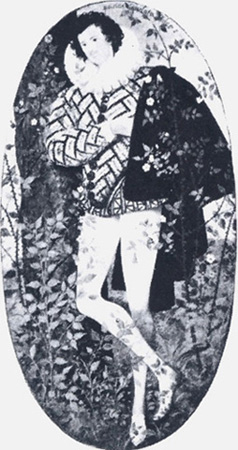
Hilliard Young Man among Roses c. 1587
Hilton Roger (1911–75). British painter. From 1957 – and permanently from 1965 – he worked in Cornwall, associated with the St Ives group of artists, doing semi-abstract paintings, e.g. June (1953).
Hiroshige Ando Tokitaro called (1797–1858). Japanese artist of the Ukiyo-e school, one of the great masters of the coloured woodcut. He adapted block printing to landscape subjects being best known for his poetical prints of the Yedo (Tokyo) district and the old high road to Kyoto. His work exerted a powerful influence on the Impressionists and other 10th-c. European artists.
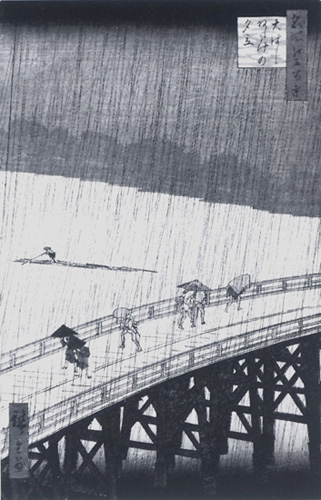
Hiroshige Shower on the Ohashi Bridge near Ataka 1857
history painting. Alberti, in the 15th c., used the word istoria to describe any subject picture with more than I figure. In the 17th c., h. p. had come to mean pictures with subjects taken from the histories, that is poetry, history (especially of antiquity) and religion; it was held to be the highest form of art. In the 18th c. Reynolds stated ‘a history painter paints man in general: a portrait painter, a particular man, and consequently a defective model’. Scenes of contemporary history in modern dress were only slowly accepted at the beginning of the 19th c.
Hitchcock George (1850–1913). U.S. Impressionist painter who lived most of his life in Holland specializing in Dutch genre subjects.
Hitchens Ivon (1893–1979). British painter. Studied at the St John’s Wood School of Art and at the R.A. schools. He belonged to the London Group and the Seven and Five Group. He lived most of his life in the heart of the Sussex countryside, and his paintings are concerned with communicating the poetic beauty of his environment. His main influence is Matisse, and whilst his work borders on abstraction, he never divorces himself completely from natural forms.
Hobbema Meindert (1638–1709). Dutch painter of landscape. A period of activity while he was the pupil and friend of J. van Ruisdael ended when H. became an excise officer in 1668. He painted few works after this, but The Avenue, Middelharnis, one of the most popular of all Dutch naturalistic landscapes, is an exception, and is now dated 1689. Neglected and poorly paid in his lifetime, H. was the favourite of English landscape painters and collectors of the 18th and early 19th cs. His quiet scenes lack the dramatic qualities of Ruisdael’s. All detail is subordinated to the overall effect. The contrast in colour between the red of a tile roof and grey-green foliage is very typical. Of the many variations of the same subject, The Mill is a fine example.
Höch Hannah (1889–1978). German artist, a member of the Berlin Club Dada and one of the originators of photomontage, along with Hausmann, Grosz, Heartfield and Baader. Her photomontages, e.g. Cut with the Cake Knife (c. 1919), are often larger than those of the others and differ in composition. H. used photographs, scraps of text, images of machinery, and assembled heads and bodies – often including portraits of friends and photographs of herself, e.g. Da-Dandy (1919).
Hockney David (1937– ). British artist who, more than any other British painter of his generation, has enjoyed great international and popular success from the early 1960s. H. studied at the R.C.A., London (1959–62) where he met Kitaj who influenced him to turn to figurative painting and unashamed use of literary sources. Already while at R.C.A., H. achieved distinction as an engraver with the major series of 16 etchings The Rake’s Progress (1961–3) which combined Hogarth’s narrative, from his series of the same name, and H.’s experience from his 1st visit to N.Y. He exhibited at the Young Contemporaries (Whitechapel Art Gal., 1962) 4 paintings under the general title Demonstrations of Versatility, painted in different styles and emulating the example of Picasso who was to become the major influence on H.’s development. During 1963–7 he settled in California which resulted in paintings of Californian subjects, culminating with A Bigger Splash (1967), and an ever-increasing tendency towards naturalism. This was briefly interrupted by a 2nd series of etchings, Illustrations for Fourteen Poems from C. P. Cavafy (1966) and his 1st stage designs for Alfred Jarry’s Ubu Roi (Royal Court Theatre, 1966). From 1968 to 1971 he painted a number of double portraits including Mr and Mrs Clark and Percy (1970–1), while in 1969 he executed another series of etchings, Six Fairy Tales from the Brothers Grimm. H. has always drawn profusely: a book, Travels with Pen, Pencil and Ink, was published in 1978. From 1975 he designed frequently for the stage: Stravinsky’s The Rake’s Progress (Glyndebourne 1975), Mozart’s The Magic Flute (Glyndebourne 1978) and 2 triple bills at the N.Y. Metropolitan Opera House (L’Enfant et les sortilèges, Parade and Les Mamelles de Tirésias, 1980–1, and Le Sacre du printemps, Le Rossignol and Oedipus Rex, 1982). Also Tristan und Isolde (1987), Turandot (1991) and Die Frau ohne Schatten (1992). H. has often used photography and since 1980 he has experimented with new technology, using it in complex, Cubist-like photomontages, e.g. Grand Canyon Looking North (1982) and Jardin de Luxembourg, Paris (1985). His work has also been influenced by faxes and xeroxes, e.g. Hotel by the Sea, Tennis and Breakfast with Stanley in Malibu (all 1989). H.’s most recent paintings include Where Now? followed by his group called ‘Some Very New Paintings’ (all 1992).
Hodgkin Sir Howard (1932– ). British painter. H. followed an independent course from the mainstream art movements of the 1960s and 1970s; he has developed his own vocabulary, painting with careful and prolonged deliberation the memory of daily life encounters with friends. H.’s paintings defy distinction between figurative and abstract art, and are intimate, in the tradition of Vuillard and Matisse; at times they recall Indian art on which he is an expert. His works, regardless of scale, invite the viewer to enter their theatrical space and are intense and brilliant in colour, and highly physical.
Hodgkins Frances (1870–1947). New Zealand painter whose best work was done in watercolour. From 1900 she lived in Britain and France. Her early work was Impressionist but after World War I she evolved a poetic personal style of landscape and still-life painting which grew increasingly closer to abstraction.
Hodler Ferdinand (1853–1918). Swiss painter, a precursor of Expressionism. Deliberately rejecting Impressionism, he developed a precise and expressive linear style which relates to the German Jugendstil movement. He painted landscapes, portraits and large-scale historical and mythological subjects, but his fame rests on his symbolical works such as Night, Disillusioned Souls and Towards the Infinite. The combination of realism and mysticism in these paintings gives him a solitary place among the artists of his time.
Hofer Karl (1878–1955). German Expressionist painter. He spent several years in Paris and Rome before World War I. His work was condemned as ‘degenerate’ by the Nazis and he was forced to give up teaching; he was later president of the Berlin Academy (1945–55).
Hofmann Hans (1880–1966). German painter and teacher who settled in the U.S.A. in 1931. He was a friend of Matisse, Delaunay, Braque and Picasso in Paris before World War I. In 1915 he opened an art school in Munich and in 1933 another in N.Y. which powerfully influenced the development of contemporary U.S. painting. His work was representational in the Expressionist tradition until the early 1940s when he began to develop an exuberant abstract style.
Hogarth William (1697–1764). British painter, engraver and caricaturist whose innovations in art and genius in depicting the English national character give him an importance even beyond his great talent as an artist. H. was trained as an engraver on plate. He studied painting at the rudimentary academies then open in London but undoubtedly profited more from his study of European paintings from engravings and his incredible visual memory. Later he apprenticed himself to Sir James Thornhill, marrying Thornhill’s daughter in 1729 and inheriting from him the academy which was to be a forerunner of the R.A. H. won an early reputation for small groups and conversation pieces, e.g. Assembly at Wanstead House, and for brilliantly captured dramatic scenes, such as the many versions of The Beggar’s Opera. In 1731 he won a far wider fame with the first of his story-series of paintings, The Harlot’s Progress. This form was quite new, certainly to secular painting. The series combined the appeal of the street ballad with that of a play, having a strong plot, allusions to contemporaries and a moral none could miss. So popular were the engravings made from this series that H. was forced to defend himself by promoting a Copyright Act before issuing the later series: The Rake’s Progress, Marriage à la Mode and The Industrious and Idle Apprentice. Similar in style are the 4 electioneering paintings and the famous O the Roast Beef of Old England. H. campaigned vigorously in his engravings against cruelty, the drinking of crude spirit and the domination of English taste by foreign artists. He undoubtedly suffered as a painter from the prejudice against native-born artists and from his own popularity as a propagandist and caricaturist. In 1753 H. publ. The Analysis of Beauty. This was in part a polemic against uncritical appreciation in the arts and in part a serious contribution to aesthetics, describing a ‘line of beauty’ supposed to be present in all works of visual art. His history paintings, Pool of Bethesda and The Good Samaritan were ignored, his Sigismunda was abused; even the originals of his famous engravings often remained unsold or were sold for very little. More important, H.’s unusual talent as a portrait painter went unrewarded. Fine examples are Captain Coram, Graham Children, William Jones, Self-portrait with Pug, The Artist’s Servants, a masterly study of contrasting character, and the vigorous, charming and technically fascinating Shrimp Girl.
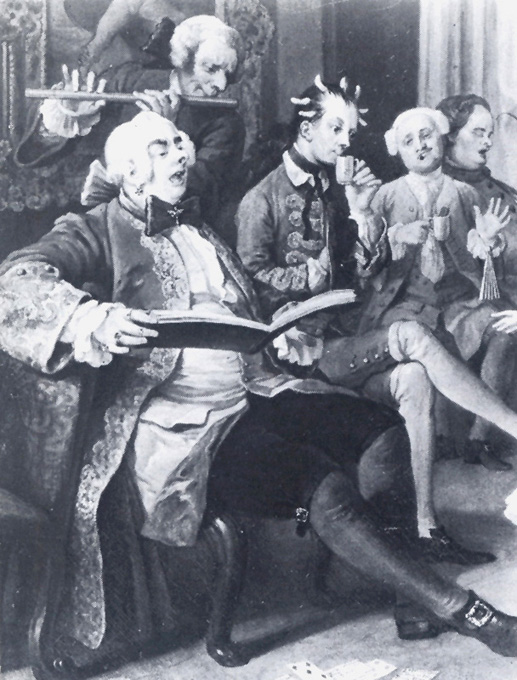
Hogarth Scene 4 (detail) from Marriage à la Mode 1745
Hohokam. Pre-historic N. American Indian culture, centred on the Gila and Salt rivers, Arizona; it fl. c. 400–1400 AD. Its colourful products include remarkable polychrome pottery, animal carvings in stone and quartzite (related in style to Anasazi sculptures) and cire perdue copper castings.
Hokusai Katsushika (Nakajima Tet-Sujiro) (1760–1849). Extraordinarily prolific Japanese painter and graphic artist, to Europeans the most famous exponent of the colour print, which had great influence on Western painting. He produced his greatest work between 1818–30, The Wave being perhaps his best-known print.
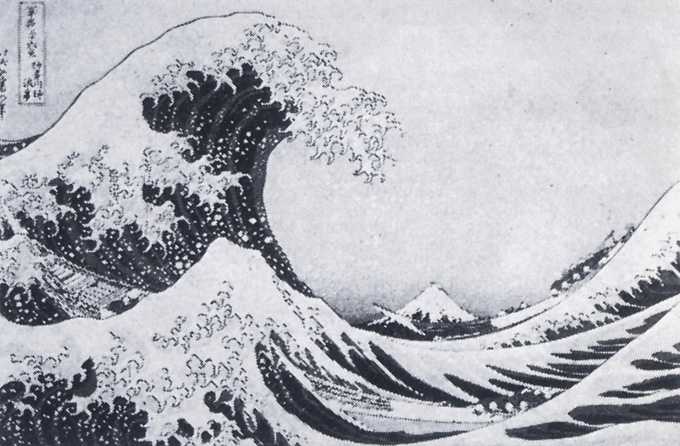
Hokusai The Wave c. 1820
Holbein Hans the Younger (1497/8–1543). German artist. H.’s father, Hans H., the Elder, had a large workshop in Augsburg. When this was disbanded, H. and his brother Ambrosius apprenticed themselves to a painter in Basel. H. soon won a wide reputation for his work undertaken for the Basel book printers. Besides designs for wood blocks, he was already painting portraits and commissions for churches. In his larger works a certain awkwardness and over– crowding is noticeable. In 1517 H. visited Lucerne and may have entered N. Italy. Returning to Basel, he married and quickly became a citizen of importance. At this period his fame was spread throughout Europe by the ills to the Luther Bible (1522) and the woodcuts of the famous Alphabet of Death and Dance of Death. Despite this success, H. was driven by doubts of his financial future during the disturbed conditions of the Reformation to seek work in Britain. During his 1st visit in 1526 he was patronized by the circle of Sir Thomas More. He went back to Basel for a period, but was in Britain once more in 1532. His patrons of the 1st visit were disgraced or dead. H. first painted the German merchants of the steelyard and was then introduced to the king. Until his death H. was employed by Henry VIII in a wide assortment of tasks, ranging from designing court costumes, silverware, jewellery and triumphal arches to painting the actual and prospective brides of the monarch. Outstanding among H.’s portraits are the superb Christina of Denmark, George Gisze, The Artist’s Wife and 2 Children, Anne of Cleves and his ‘showpiece’ the double portrait, The Ambassadors. H. made many drawings for portraits and those of the court ladies are among the masterpieces of portrait drawing. Of H.’s other work, his miniature painting is important for itself, e.g. Mrs Pemberton, and for its influence on British miniature painting. H.’s outstanding early works for churches are the Dead Christ and the Madonnas of Solothurn and Darmstadt.
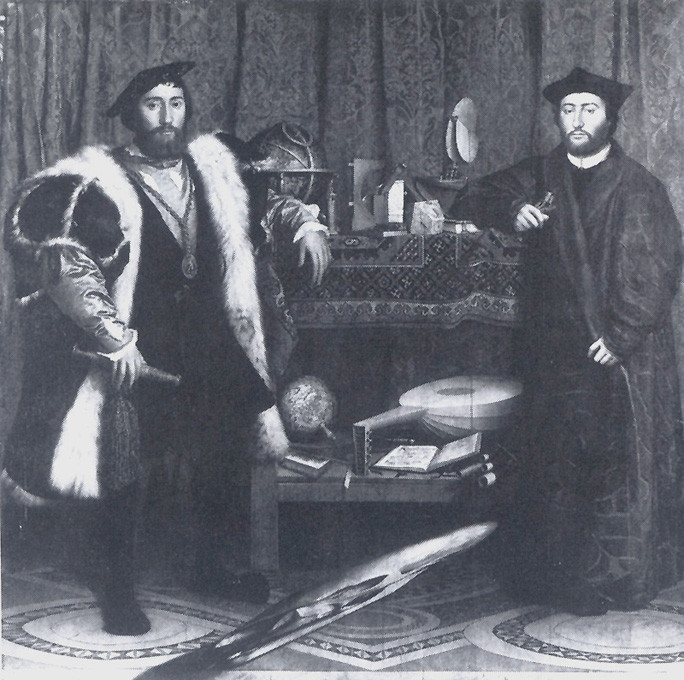
Holbein The Ambassadors 1533
Hollar Wenceslaus (1607–77). Draughtsman and engraver born in Prague; worked in Britain from 1636. His output was enormous and covered a wide range of subjects. His topographical views of London before the Great Fire of 1666 and his works on costume, Ornatus Muliebris Anglicanus (1640) and Theatrum Mulierum (1643), are of considerable historical interest.
Holzer Jenny (1950– ). U.S. artist whose work consists of aphorisms and exhortations in signs (electronic, printed or inscribed in stone, etc.) which often appear in public spaces – like the electronic signboard in Times Square in N.Y. H.’s messages or ‘Truisms’ (1977–9) strongly reflect political, feminist and environmental issues (e.g. ‘MONEY CREATES TASTE’), as do her ‘Inflamatory Essays’ (1979–82) and the ‘Living’ series (1980–2) which make use of longer texts. The ‘Survival’ series (1986) consists of 10-ft (3 m.) Unex signs and also anonymous stickers of messages placed on parking meters and public telephones, 1st in N.Y. and then in various European cities. Another series, ‘Lament’ (1987–90), made use of light-emitting diode (LED) signs and corresponding inscriptions engraved on sarcophagi, e.g. ‘… THE NEW DISEASE CAME. I LEARN THAT TIME DOES NOT HEAL. I DO NOT WANT TO STOP KNOWING ALL MY FACTS.’ The major exhibition of her work at the Guggenheim Museum, N.Y. (1989–90), made use of the entire rotonda for which she programmed hundreds of texts into the 535-ft-long electronic message board on the rotonda’s spiral, while at entrance level a number of granite benches had messages inscribed on them. In 1990 she became the first woman to represent the U.S.A. in the Venice Biennale.
Homer Winslow (1836–1910). U.S. painter, pictorial journalist and ill. He covered the Civil War for Harper’s Weekly and achieved recognition as a painter with Prisoners from the Front (1866). Between 1867 and 1880 his subjects were broadly treated rural genre scenes, e.g. Gloucester Farm (1874) but after a visit to Britain (1881–2) he returned to violent realistic paintings connected with the sea, e.g. The Life Line (1884). Later he adopted an Impressionistic watercolour technique.
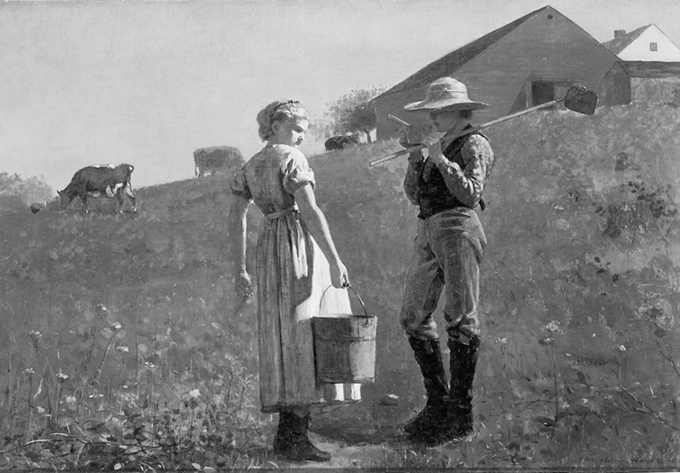
Homer Gloucester Farm (detail) 1874
Hondecoeter Melchior D’ (1636–95). Dutch painter notable for his pictures of birds. He studied under his father Gijsbert Gillisz (1604–53), an animal painter, and his uncle J. B. Weenix, and worked at The Hague and Amsterdam.
Hone Nathaniel (1718–84). Irish-born portrait miniaturist in enamel and watercolour who worked in Britain; founder-member of the R.A. From 1750 to 1752 he studied in Italy and subsequently painted some large-scale portraits in oils. He satirized Reynolds in a painting entitled The Conjurer (rejected R.A., 1775).
Honthorst Gerard or Gerrit van (1590–1656). Dutch painter, trained in Utrecht, but in Rome by about 1610. H. was very popular in Italy, where he was known as ‘Gherardo delle Notti’ because of his dramatically lit night scenes after Caravaggio (Christ before the High Priest). H. was largely responsible for bringing the innovations of Caravaggio to Holland on his return there in 1620. Enjoying an international reputation, he was invited to the English court in 1628 (Charles I and Henrietta Maria with the Liberal Arts) and to the Danish court in 1635. As Dutch court painter he painted the Baroque decorations at Huisten-Bosch.
Hoogh or Hooch Pieter de (1629–after 1683). Dutch painter, the contemporary of N. Maes and Vermeer of Delft and, like them, a recorder of scenes of middle-class life. H. is first recorded as ‘painter and footman’ in the household of a rich merchant. After 1654 he lived in Delft and his art declined when he moved to Amsterdam, c. 1663, and tried to portray a higher stratum of society. Like Vermeer, he was interested in optics and the fall of light. His colour harmonies are simple and very effective. Among his best works are: Courtyard in Delft, Woman Peeling Apples, The Pantry and The Linen Cupboard.
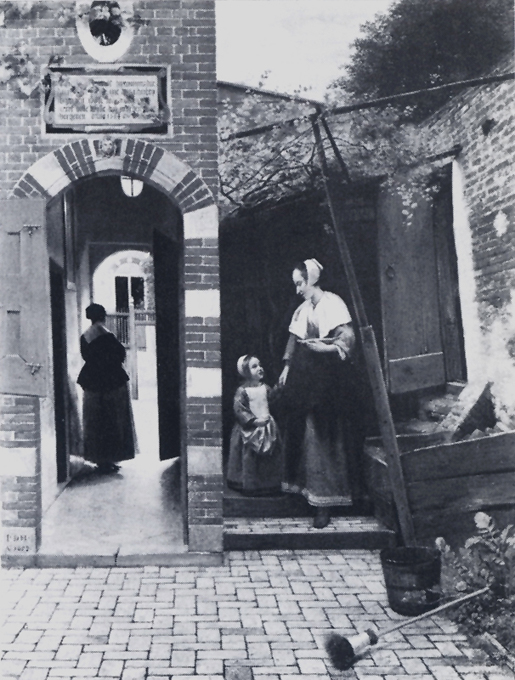
Hoogh Courtyard in Delft 1658
Hoogstraten Samuel van (1627–78). Dutch painter of portraits, genre and religious subjects and architectural fantasies. He studied under Rembrandt in Amsterdam. He was famous for his experiments with trompe l’œil and perspective illusionism, e.g. his peepshow box.
Hopper Edward (1882–1967). U.S. painter. He was a student of Henri and showed at the Armory Show. In the late 1930s he emerged as a major realist painter of the U.S. scene, developing a personal, severe style of depiction and going against the current of European influence and abstraction. His work is formally sharp with harsh contrasts of light and shadow, and despite its figurative content is essentially modernist in spirit, which accounts for his reputation as a master of 20th-c. U.S. art.
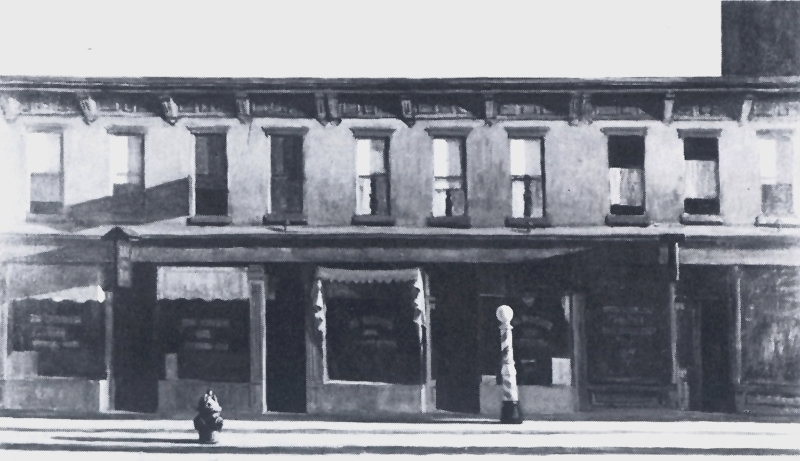
Hopper Early Sunday Morning 1930
Hoppner John (1758–1810). Portrait painter born in Britain of German parentage. He gained sufficient contemporary popularity to rank as Lawrence’s chief rival, although his style was based almost entirely on borrowings from other artists including Reynolds, Romney and later Lawrence.
Horlor Joseph (fl. 1834–66). British painter of landscapes and coastal subjects, particularly in the English West Country and Wales. His works enjoyed a collectors’ vogue from the late 1960s.
Horn Rebecca (1944– ). German sculptor, Installation, Performance, action and video artist, and film maker in whose work ‘themes of human vulnerability, emotional fragility, and desire pervade the narrative that binds each of her separate productions.’ In her sculptures, installations and films the body interacts ritualistically with the environment and becomes transformed, e.g. the large-scale Performance Head Extension (1972), which she also filmed, and the film Berlin Exercises: Dreaming Under Water (1974–5). In Overflowing Blood Machine (1970) the body and the machine merge, illustrating the common theme in H.’s work. She has also frequently used animal imagery in such works as Unicorn (1970), Kiss of the Rhinoceros (1989) and Drunken Beetle (1991–3). H.’s films and performances, using sculptural and Kinetic devices, are often autobiographical narratives and memory fantasies which combine Bauhaus, Constructivist and Kinetic references, creating an individual poetic discourse, e.g. a collaboration with Kounellis (1986) in Vienna’s Theater am Steinhof, the site of an insane asylum, The Concert in Reverse (1987), a site-specific Installation at Münster, and the film Buster’s Bedroom (1991). In 1993 a major retrospective of H.’s work was held at the Solomon R. Guggenheim Mus., N.Y., which included a temporary, site-specific Installation, Paradiso, in the museum’s rotunda and the lobby, and Inferno, in the Guggenheim Museum, SoHo. Called The Inferno-Paradiso Switch, it alluded to Dante’s Divine Comedy.
Hornebolte Lucas (c. 1490/5–1544). Born in Ghent, he and his family settled in Britain in 1525. They were the leading exponents of the Ghent-Bruges school of illuminators. H. was a court painter under Henry VIII for almost 20 years; also painted portrait miniatures and taught Holbein. He is considered to be the founding father of the British miniature. 23 extant miniatures are attributed to H., and they are mostly portraits painted ad vivum with no preliminary drawing, a feature that was to be the essence of the British limning tradition.
Hoskins John (c. 1595–1665). British portrait miniaturist. His early style derives from Hilliard. He became famous for miniature copies of Van Dyck’s portraits.
Houbracken Arnold (1660–1719). Dutch painter remembered as the author of Du groote Schouburgh … (1718–21), an important source of information about 17th-c. Dutch and Flemish painters despite its inaccuracies. His son Jacobus (1698–1780) was a portrait engraver.
Houckgeest Gerard (c. 1600–61). Dutch painter who worked in Delft. He specialized in church interiors.
Houdon Jean-Antoine (1741–1828). French sculptor who studied under J.-B. Pigalle and J.-B. Lemoyne and worked in Rome from 1764 to 1768; there he came under the influence of J. J. Winckelmann and his circle. For some time he followed the style of late Baroque sculpture but gradually adopted the colder manner of Neoclassicism. His best and most numerous works are portraits, which include busts of Diderot, Rousseau, Voltaire and George Washington.
Hours, Book of. Book of Hours
Hovenden Thomas (1840–95). Irish-born U.S. painter of the Pont-Aven school. H. painted historical and genre subjects, often large-scale, colourful and sentimental pictures of Breton peasants and of Americans from the Civil War period.
Hoyland John (1934–2011). British painter. After studies at Sheffield College of Art (1951–6) and the Royal Academy Schools (1956–60), his work became oriented towards U.S. Color-field painting following the 1956 Tate Gal. exhibition ‘Modern Art in the USA’. From 1964 he made frequent visits to the U.S.A., often for extended periods, working and teaching. He met Frankenthaler, Louis, Motherwell, Noland, Olitski and the critic Greenberg who introduced him to the work of Hofmann which had great impact. H. was the most prominent British Color-field painter, often using thick impasto and brilliant colours, predominantly red and green.
Hoysala. Medieval Indian dynasty of Mysore (c. 1110–1327). The Keshava temple at Somnathpur (late 13th c.) is characteristic of H. architecture with star-shaped plan, fine filigree sculptural decoration and flat roofs. Other classic sites are at Belur and Halebid. H. sculpture includes a renowned stele (stone slab) of the elephant-headed Hindu god Ganesha and sculptures of the sun god Surya and of Durga.
Hsia Kuei (fl. 1180–1230). Chinese landscape painter, with Ma Yuan originator of the classic S. Sung style. H. K.’s style is generally vigorous using stabbing brush-strokes to produce bold, atmospheric effects.
Huaxte. Mexican Pre-Columbian culture fl. AD 900–1519. The H. produced large limestone sculptures and pottery decorated with black designs on a cream base.
Huber Wolf (c. 1490–1553). German painter, draughtsman and woodcut artist who, after Altdorfer, was the most important member of the Danube school. He worked in Regensburg and Passau. Few paintings by him are known and it is in his woodcuts and drawings that his lyrical approach to landscape can best be seen.
Hudson Thomas (1701–79). British portrait-painter, son-in-law and pupil of J. Richardson the Elder and master of Reynolds. His sound, conventional work was popular before the rise of Reynolds.
Hudson River school. Name loosely applied to a number of 19th-c. U.S. Romantic landscape painters who worked mainly, though not exclusively, in the vicinity of the Catskill Mountains and the Hudson River. They were never an organized group but shared a sense of wonderment at the grandeur of the newly discovered U.S. landscape. Painstaking attention to detail is a common feature of their style. Bierstadt, Church, Cole and Doughty are among the many representatives of the school.
Huebler Douglas (1924–97). U.S. Conceptual artist who, since 1971, has been working on a series which aims to photograph ‘everyone alive’. Variable Piece 28, 1970, consists of 23 photographs of a child and H.’s statement. ‘I painted till 1961. … As the painting had become an “object”, I went “off the wall” and began making constructions. …’
Huet Jean-Baptiste (1745–1811). French painter (of animal and pastoral subjects) and engraver, pupil of J.-B. Leprince. He designed for Gobelins and Beauvais tapestries, following the style of Boucher.
Huet Paul (1803–69). French Romantic landscape painter and engraver, influenced by Delacroix, Constable and Bonington.
Hughes Arthur (1832–1915). British painter of the later phase of Pre-Raphaelitism. His best-known paintings date from the 1850s and include April Love and The Eve of St Agnes (both 1856). H. also completed book ills for Christina Rossetti’s Sing Song (1872); he died a recluse.
Huguet Jaime (fl. 1448–87). Spanish painter of the Catalan school who worked in Barcelona. Not only were his paintings influential in Spain but, through exporting altarpieces to Sardinia, he was responsible for the development of a Catalan school there. His figures are elongated and sumptuously clothed with rather similar lean sad features. Extensive use of gold paint also characterizes his work.
Hundertwasser Fritz (1928–2000). Austrian painter who studied at Academy of Fine Arts, Vienna. At 1st influenced by Surrealism, H. developed a more abstract style, but his pictures usually include figurative references, in the tradition of Klimt and the painters of the Sezession.
Hunt Richard (1935– ). African-American sculptor and print maker whose early influences include Gonzáles and who studied at the Art Institute of Chicago. Highly distinguished as one of the U.S.A.’s major abstract sculptors of welded metal, steel, aluminium, copper and bronze. His work – including major public commissions, e.g. Freedmen’s Column, at Howard University, Washington – although abstract, suggests organic and figurative forms.
Hunt William Holman (1827–1910). British painter who, with D. G. Rossetti and J. E. Millais, founded the Pre-Raphaelite Brotherhood and alone remained faithful to its principles. He visited Palestine to obtain the correct settings for The Scapegoat (1856). H. painted the famous The Light of the World (1854). His unpretentious portraits and small landscapes have considerable realistic force.

Holman Hunt The Scapegoat 1856
Hunt William Morris (1824–79). U.S. painter. At first associated with the Düsseldorf school, he then went to France where he worked with the Barbizon painters. From the mid-1850s he popularized their style in the U.S.A.
Huysum Jan van (1682–1749). Dutch flower painter who imitated nature with unequalled virtuosity; he worked in Amsterdam. He used a higher range of tones in his elaborate compositions than any Dutch flower painter before him and was responsible for introducing light backgrounds. He had many imitators, above all his brother Jacob (1687–1740) who, working in Britain from c. 1721, marketed Jan’s work as his own. Their father Justus (1659–1716) was also a flower painter.
Hyper Realism. Super Realism
Hypnerotomachia Poliphili. One of the world’s most remarkable books; written (1467) by F. Colonna. The 1st ed., using F. Griffo’s 3rd roman fount, was printed in 1499 by Aldus Manutius in Venice, with 200 woodcuts by an unknown artist, and is in itself the most famous illustrated incunabulum. It is an obscure allegorical narrative, written in a mixture of languages including Italian, Greek, Latin and Hebrew, and telling of a dream journey through the realms of Art and Free Will. The numerous detailed architectural descriptions are partly fantasy and partly derived from a knowledge of classical architecture. Colonna particularly delighted in the descriptions of ruins and decay, symbols of the impermanence of human life. These imaginary monuments were an endless source of themes to Renaissance painters, sculptors and engravers.